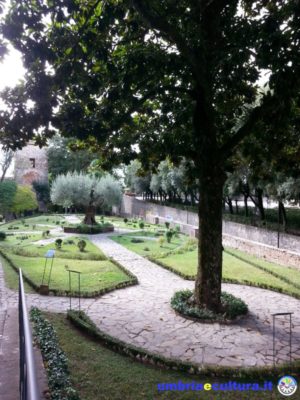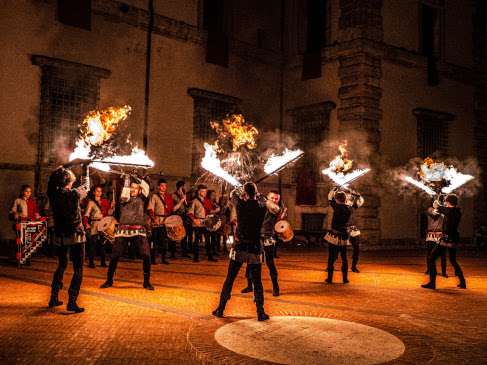Inside the abbey of San Pietro in Perugia, a treasure trove of wonders such as the Cathedral and the Treasures Gallery, it is possible to stroll in the arcane charm of the Medieval Garden.
Numerology, symbolism, religion… every particular contributes to create an aura of intriguing mystery around this “hortus conclusus” designed on the basis of medieval culture and Benedictine conceptions.
To walk in the medieval garden means walking the path of man towards salvation, through sin and penance, until to reach the gift of Paradise and eternal life.
The itinerary begins with a circular flowerbed (the circle is a symbol of perfection) in the center of which a large magnolia grandiflora represents the cosmic tree.
This first flowerbed is followed by another of an elliptical shape, to symbolize the primordial cosmic egg from which life originates: it is the representation of the garden of Eden, the earthly paradise, a condition of perfection given by God to men. There are numerous references to numerology with the repetition of the number four: four are the quadrants of the flower bed, each dedicated to an element: Water, Fire, Earth and Air: on the respective flower beds are visible, represented with boxwood , the zodiac signs (twelve, therefore 4 multiplied 3, the perfect number) and the plants connected to them. It was believed, in fact, that to each zodiac sign, therefore to each person belonging to a certain sign, corresponded plants with particularly effective effects. A curiosity: each of these plants has been mentioned at least once in the Bible.
At the center of the flowerbed a 300-year-old olive tree represents the tree of light and science (the oil produced with its fruits fed the lamps, therefore it was considered a bearing light tree) from which four small wellspring depart, as symbol of the four liquids that nourished (and nourish) humanity: water, milk, honey and wine.
Then there is a fig tree, the plant of Good and Evil, and the palm tree, considered a tree of perfection, before falling into the Sacred Wood: the cypress, slender upwards was considered the tree of spiritual life, a connection between the earth and the divinity, the wild persimmon, called the tree of Saint Andrew because it is believed that the cross of his martyrdom was made with its wood. A quercus ilex is also called the tree of the cross. The sacred forest (or dark forest) symbolizes the period of sin but also the moment of atonement which leads to redemption, therefore to the following area.
After the forest there is the Hortus Sanitatis or Giardino dei Semplici, with a series of medicinal plants, used in medicine until 1700. The cultivation of medicinal plants was followed by a monk with specific health functions, who, on the basis of his knowledge, in addition to cultivating plants, was in charge of treating the monks or pilgrims in transit in need of care.
Next to the Hortus Sanitatis there is the Hortus Holerorum, or the vegetable garden of aromatic and food plants.
A large pine tree lying on the wall is the Merlin wizard tree, so named because the famous wizard is believed to have inhabited a house built on a pine tree.
The path in the Medieval Garden continues going up to the Podium, from which you can enjoy a wonderful view on Assisi and Subasio mountain, Spello and the Umbrian Valley embracing the Umbrian-Marche Apennine mountains.
The journey back to the starting point continues to the tanks (surrounded by the Theatrum stands) where the monks bred carp for internal use and for pilgrims.
The Pomarium, orchard, is another place where the reference to numerology is strong, to symbolize the perfection of nature: the Fibonacci sequence is reproduced on the floor, wonderfully respected by the plants in their growth.
A palindrome phrase “si siede is si non siede non is” expresses the Benedictine concept of action that gives meaning to existence.
A memorial stone, indicating the distance between this place and the seat of San Pietro, reminds us that the Via Francigena towards Rome passed from here: the medieval arch under which we pass was in fact an ancient door crossed by the road that led the pilgrims to their destination.
The path takes uphill, called Yddrasil to symbolize man’s effort to achieve salvation: Yddrasil is still the arch-type of the tree-axis of the world, whose roots sink into the earth and whose branches touch the sky to symbolize the mystery of ascent. The tension upwards allows us to get to the water lily or cosmogonic ovulation tank: the oval shape, the presence of water, are all symbols that refer to life, in its original state, the presence of these flowers suggests prolific and uncontaminated life, whitenessed by their petals that open to the sun.
Benedetta Tintillini
Find the San Pietro Abbey on Google Maps:



